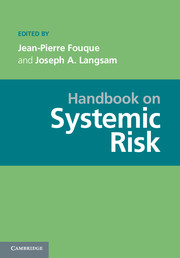Book contents
- Frontmatter
- Contents
- Contributors
- Introduction
- PART I DATA: THE PREREQUISITE FOR MANAGING SYSTEMIC RISK
- 1 Systemic Risk Information Requirements: Current Environment, Needs, and Approaches for Development
- 2 Aligning Models and Data for Systemic Risk Analysis
- 3 Applying FpML
- 4 Data Integration for Systemic Risk in the Financial System
- 5 Semantics in Systemic Risk Management
- PART II STATISTICS AND SYSTEMIC RISK
- PART III MEASURING AND REGULATING SYSTEMIC RISK
- PART IV NETWORKS
- PART V SYSTEMIC RISK ANDMATHEMATICAL FINANCE
- PART VI COUNTERPARTY RISK AND SYSTEMIC RISK
- PART VII ALGORITHMIC TRADING
- PART VIII BEHAVIORAL FINANCE: THE PSYCHOLOGICAL DIMENSION OF SYSTEMIC RISK
- PART IX REGULATION
- PART X COMPUTATIONAL ISSUES AND REQUIREMENTS
- PART XI ACCOUNTING ISSUES
- References
2 - Aligning Models and Data for Systemic Risk Analysis
from PART I - DATA: THE PREREQUISITE FOR MANAGING SYSTEMIC RISK
Published online by Cambridge University Press: 05 June 2013
- Frontmatter
- Contents
- Contributors
- Introduction
- PART I DATA: THE PREREQUISITE FOR MANAGING SYSTEMIC RISK
- 1 Systemic Risk Information Requirements: Current Environment, Needs, and Approaches for Development
- 2 Aligning Models and Data for Systemic Risk Analysis
- 3 Applying FpML
- 4 Data Integration for Systemic Risk in the Financial System
- 5 Semantics in Systemic Risk Management
- PART II STATISTICS AND SYSTEMIC RISK
- PART III MEASURING AND REGULATING SYSTEMIC RISK
- PART IV NETWORKS
- PART V SYSTEMIC RISK ANDMATHEMATICAL FINANCE
- PART VI COUNTERPARTY RISK AND SYSTEMIC RISK
- PART VII ALGORITHMIC TRADING
- PART VIII BEHAVIORAL FINANCE: THE PSYCHOLOGICAL DIMENSION OF SYSTEMIC RISK
- PART IX REGULATION
- PART X COMPUTATIONAL ISSUES AND REQUIREMENTS
- PART XI ACCOUNTING ISSUES
- References
Summary
Abstract The recent financial crisis has brought to the fore issues of quantifying and reducing systemic risk. This focus has precipitated the exploration of various methods for measuring systemic risks and for attributing systemic risk contributions to systemically important financial institutions. Concomitant with this stream of research are efforts to collect, standardize and store data useful to these modeling efforts. While discussions of modeling approaches are pervasive in the literature on systemic risk, issues of data requirements and suitability are often relegated to the status of implementation details. This short chapter is an attempt to deepen this discussion. We provide a 2 × 2 mapping of modeling strategies to key data characteristics and constraints that can help modelers determine which models are feasible given the available data; conversely, the mapping can provide guidance for data collection efforts in cases where specific analytic properties are desired. The framework may also be useful for evaluating, at a conceptual level, the trade-offs for incremental data collection. To provide background for this mapping, we review the analytic benefits and limitations of using aggregate vs. micro-level data, provide background on the role of data linking and discuss some of the practical aspects of data pooling including concerns about confidentiality. Throughout the chapter, we include examples from various domains to make the points we outline concrete.
Introduction
Modern statisticians are familiar with the notion that any finite body of data contains only a limited amount of information on any point under examination; that this limit is set by the nature of the data themselves, and cannot be increased by any amount of ingenuity expended in their statistical examination; that the statistician's task, in fact, is limited to the extraction of the whole of the available information on any particular issue.
R.A. FisherInformation
- Type
- Chapter
- Information
- Handbook on Systemic Risk , pp. 37 - 65Publisher: Cambridge University PressPrint publication year: 2013
References
Accessibility standard: Unknown
- 9
- Cited by
